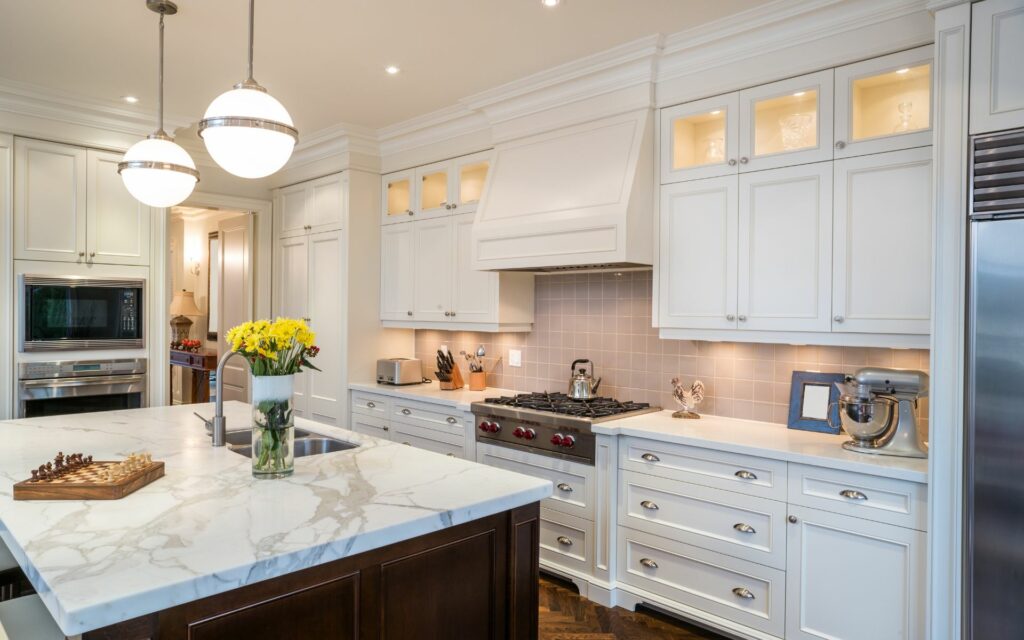Marble countertops hold an undeniable magic you simply can’t resist. The natural patterns dancing across the polished stone make each slab truly one-of-a-kind. More importantly, the translucent glow and intricate detail of black marble countertops offer to transform basic countertop real estate into a work of art.
Yet as much as you swoon over the timeless beauty of marble in regal estates or museum cafés, uncertainty has likely kept these stunning counters out of your own home. Questions linger in your mind:
- Is natural marble too high maintenance for a busy kitchen?
- How much care does marble require daily?
- Why does marble cost so much more than trendy quartz?
- Is installing marble asking for cracks or stains down the road?
You resolved to get informed answers this time rather than letting apprehension deprive you any longer. Off you went to a local countertop store highly recommended for its specialty in natural stone slabs. Immersed amongst the impressive marble collection, you uncovered everything you need to decide whether marble countertops deserve a place in your home too.
The Natural Beauty and Timelessness of Marble
Marble has adorned grand entryways, walls, floors, fireplaces, fountains, and sculptures since ancient times. This classic natural stone originates from quarries across the world, particularly Italy and Greece.
The unique veining patterns and subtle color variations give the matte finish of each marble slab a distinct beauty. Soft whites swirl with grey veins, creams, and deeper natural mineral hues. Popular marble varieties include:
- Carrara: Bright white background with subtle grey veining
- Statuario: White background with bold grey/black veining
- Calacatta: Warm white background with thick grey to gold veins
- Crema Marfil: Beige/cream background with white veins
When lit well, the translucent marble allows light to reflect off the stone for a soft glow. The natural patterns make marble countertops the striking focal point in both traditional and modern kitchen and bathroom designs.
Beyond aesthetics, natural marble withstands the test of time. Part of stone’s intrigue comes from originating in the earth over millions of years under heat and pressure. Marble maintains its structure and beauty for decades with proper sealing and care.
Homes with marble slabs, floors, walls, columns, entryways, and fireplaces from hundreds of years ago show little wear. That staying power allows the marble to elevate kitchens and bathrooms from temporary trends to timeless features.
Factors To Consider Before Choosing The Best Marble Countertops
Marble offers an exceptional look, but natural stone comes at a price. Marble presents more considerations regarding cost, vulnerability, and maintenance compared to engineered quartz or granite. Keep these factors in mind when deciding between countertop materials:
Upfront Cost
As a premium natural stone, marble sits at the higher end of countertop costs. Expect to invest:
- $80-$250 per square foot for white marble slabs
- $150-$400 for rare, imported marble varieties
The total expense depends on the particular slab, edge profiles, cutouts needed, and professional installation. The natural origin and mining process limits the availability of rare marble types, driving prices higher.
Marble falls short of granite ($50-$100 per square foot) and engineered quartz ($70-$150 per square foot) in terms of upfront affordability. However, the elegance and luxurious aesthetic marble offers make the investment worthwhile for many homeowners. Consider marble a long-term asset that enhances resale value.
Care and Maintenance Needs
While durable in many ways, marble remains vulnerable to etching, scratching, and staining as a softer natural stone. Quartz offers superior resistance and requires very little maintenance thanks to today’s advanced engineering.
Protecting the marble surface with a quality sealant is essential but will need reapplication every 1-2 years. Avoid exposing marble counters to acidic foods like lemons, tomatoes, wine, or vinegar. Using trivets, cutting boards, and placemats helps preserve marble’s beauty.
Spills should be wiped up quickly before potentially staining. Follow-up cleaning with a soft cloth and mild pH-neutral soap to gently lift soils without damaging the marble’s delicate surface.
Though small-scale professional honing or polishing may occasionally be needed, marble countertops can provide over more than a decade, of enjoyment with proper care and sealing. Weigh the maintenance effort against marble’s enduring elegance that engineering cannot replicate.
Chips and Cracks Concerns
Micro cracks and drying throughout the stone make marble more prone to damage from bumps or dropped heavy objects. Cracks propagate easier through marble compared to granite. Chips along the cutout edges or small impacts in a sink area often need repair early on.
Careful installation and intentional kitchen layouts can alleviate some of the marble’s vulnerability. Adding sufficient support brackets or corbels helps stabilize heavier countertops above cabinet base frames. Strategic placement of sinks and high-use areas can also prevent cumulative strain in certain spots.
How Marble Countertops Compare to Other Natural Stones and Quartz
Marble deserves consideration alongside other popular options like granite and quartz for kitchen countertops. Here is how the marble kitchen countertops compare to the key factors of appearance, durability, maintenance, and cost.
Marble vs. Granite Countertops
Granite makes up a key competitor as another high-end, natural stone option. Granite slabs also deliver unique, inherent beauty with less variation from Carrara and Calacatta marble. Stones like Ubatuba, New Caledonia, and Blue Bahia contain dynamic sweeping patterns across more consistent dark mineral tones.
In terms of durability, granite rates harder and more resistant to damage from cuts, scratches, heat, and spills. The higher silica content makes granite very unlikely to etch or stain under normal kitchen use. Granite requires only occasional resealing every 3-5 years.
On the downside, dark speckles scattered throughout granite’s busier mineral patterns limit light reflection. The swirls, spots, and veins show less dimension on the surface compared to marble’s translucent, prominent layers. Granite leans contemporary, while marble is a natural that provides more versatility fitting seamlessly into modern and traditional spaces.
Ultimately, granite makes an exceptional choice based primarily on durability and lower maintenance at the expense of natural beauty. Marble prioritizes aesthetics and luxury over practicality. Both offer customization to suit your style.
Marble vs. Quartz Countertops
Quartz countertops, like Caesarstone or Cambria, present the most practical option as high-performing engineered, stone countertops. Combining around 90% ground quartz crystals with polymer resins and pigments creates a durable, consistent material ideal for kitchens.
With some designs mimicking patterns from natural marble and granite, quartz introduces less color variation overall. Lacking the depth and translucency of genuine stone, engineered quartz falls short of marble’s ability to elevate a kitchen’s beauty.
On measures of durability and maintenance though, quartz outperforms marble significantly. Non-porous quartz never needs sealing and endures chips, scratches, heat, and stains remarkably well. Simply wiping with a damp cloth keeps quartz counters pristine.
Higher affordability and procurement efficiency also benefit quartz buyers. With quarries unable to meet demand for rare marble types, engineered stone guarantees buyers consistent slabs at reasonable prices. Quartz costs 20-50% less than natural stones on average.
For sustainable luxury, marble makes sense for less utilized spaces. As a practical workhorse material under constant use and possible abuse though, quartz counters fit most homeowners’ lifestyles better than black marble. Investing in marble communicates an intentional commitment to sophistication pairing elegance with diligent care.
How To Buy Marble Countertops
Once committed to welcoming marble countertops into your home, follow these steps for an ideal purchase experience:
Find a Quality Provider Specializing in Marble
Work with an established provider in your area that focuses specifically on natural stone. Ask for references to confirm previous quality work and client satisfaction. Make sure they carry high-end marble varieties like Calacatta Gold, and Statuario marble, and imported slabs.
Specialists understand how to handle and fabricate delicate marble properly using wet-cutting techniques to avoid cracking thin edges or corners. Reliable craftsmen also polish tight seams honed to near invisibility. Trying to save costs on installation often backfires on such an important investment.
Select the Right Marble Stone Slab for Your Kitchen
Natural marble slabs vary immensely in quality and appearance. Make time to visit the stone yard in person and fall in love with a particular piece. Choosing the perfect colors and veining patterns feels critical since little opportunity exists to alter or replace marble later on. Set slabs near your cabinetry if possible to envision the completed look.
White marbles like Carrara offer versatility suiting both modern and traditional spaces well. Statuario White marble makes a dramatic statement for contemporary homes preferring bold greys and contrast. Crema Marfil’s softer beige hues lend a warm, welcoming effect with a classic and elegant look.
Beyond color, inspect thickness, pitting, cracks, or uneven surfaces carefully before committing to a slab. Thicker 3⁄4 to 1-inch pieces ensure sufficient structure and durability for counters seeing heavy use. Once installed properly, premium marble countertops last in peak form despite natural aging over decades.
Design and Installation Considerations
When designing your new kitchen layout, consider marble’s vulnerabilities and benefits. For example, locate main prep and cleanup zones where quartz or granite surround the range instead of marble. Position marble sections in baking, serving, and casual dining areas receiving gentler use instead.
Frame adequate underlying support across the entire countertop span. Brackets anchored securely along the cabinet base prevent sagging over years of cumulative strain. Built-in backsplashes also help protect vertical marble areas prone to splashing or drips near sinks.
Leave no detail overlooked during template measurements. Expect a process of weeks from finalizing your order to completing installation. Use that timeframe to declutter kitchen spaces so the talented stonemasons and fabricators have full access for a smooth installation process.
Caring for Marble Countertops
Implement a diligent cleaning and sealing routine from day one to enjoy marble countertops for over a decade like installations from generations ago. Follow these care tips to preserve marble’s integrity and splendor as the focal point of your kitchen:
- Use trivets and cutting boards religiously when prepping food
- Clean spills promptly with a soft cloth and mild soap
- Avoid abrasive pads or cleansers that could scratch surfaces
- Reseal marble every 1-2 years with a penetrating sealer
- Deep clean gently with specialized marble cleanser monthly
- hone or polish small damaged areas to prevent growth
Report any concerns with cracks or stains early on to your original installer. Investing a little attentiveness upfront prevents expensive replacement and recutting costs later.
Bottomline
After understanding marble’s virtues alongside realistic care expectations, you feel informed and, likely endeared further, by how this gorgeous natural stone graces kitchens for lifetimes. Marble’s shopping complexity and installation precision intimidate, however. Let us tailor a marble wall, island, or full countertop incorporation suited to delight while promising durable daily enjoyment. From sourcing premier slabs through professional care training, you can trust American Quartz & Granite to actualize marble’s stirring potential flawlessly.
Eager to ignite ideas? Book a design meeting today to uncover options and smart ways marble’s sophisticated legacy can elevate your home for generations.




